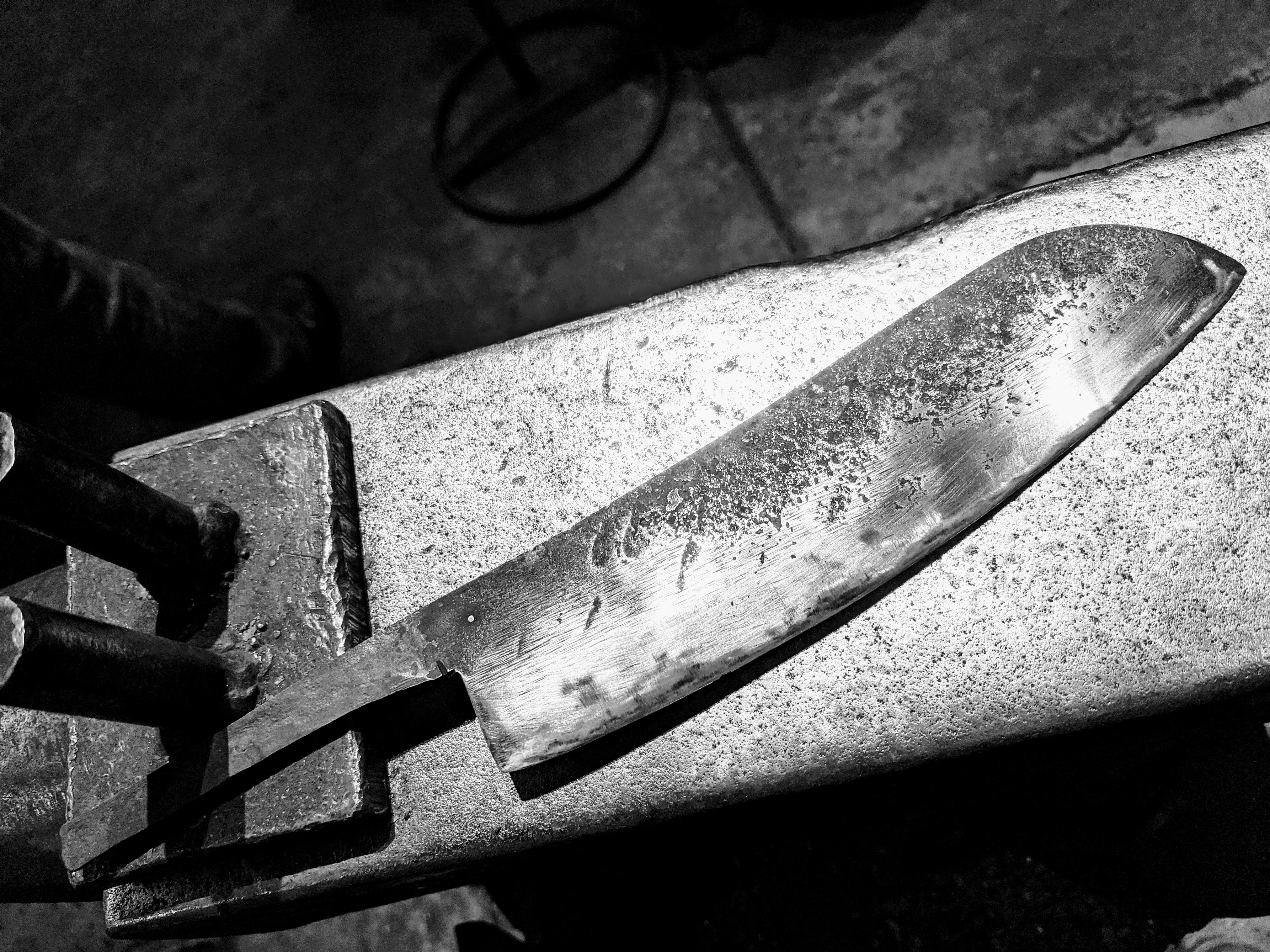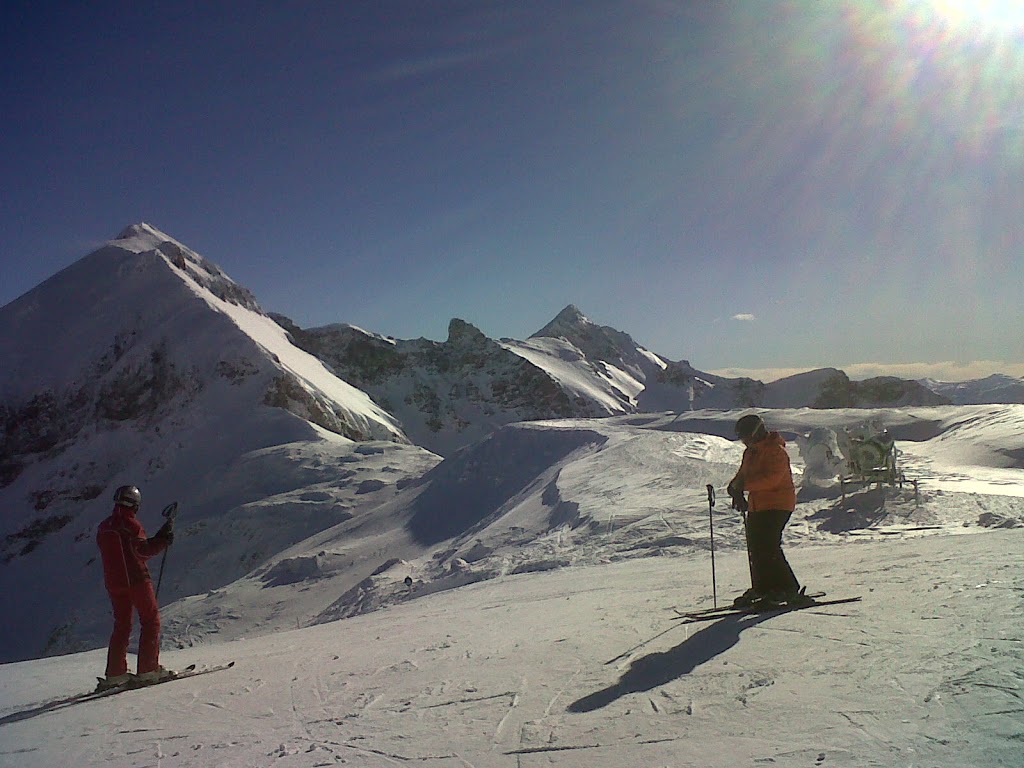A 40-minute cycle northwards via Pankow, in the rain, and then a sharp right turn and a brief meander through a U-shaped courtyard. I stop outside a building which looks like a garage, with piles of scrap metal and a workbench with a huge vice attached outside. Also outside are a small clan of men, eyeing me with amused expressions on their faces. Two of them (I’m not joking) are wearing leather jackets and have greased-back hair, while the other two are (again, not joking) wearing lumberjack shirts and snapbacks while sporting solid beards.
One of them looks like the leader so I introduce myself to him and say that I am booked onto the course with my friend who is running late, and he and his mate laugh and say that they’re not in charge and reckoned I was looking for the painting course up the road rather than this one here. Because it is a blacksmithing course, which indeed is hilarious because I am a delicate lady. But before I am able to punch anyone in the giblets, the actual blacksmith arrives. In delightful juxtaposition with the Lads, he is a young stringy bloke with a soft, deer-like face, a baggy and very holey jumper, and a tentative, quiet voice. He meekly beckons us into the workshop with his long, sooty fingers.
The workshop is exactly what you would hope for in a smithy: a dingy space cluttered with bulky tools on every surface and long racks along the back walls holding hundreds of pairs of black steel tongs and chunky hammers, each a different shape and size. There is an old bellows the size of a two-door car bolted to the ceiling and right at the end of the room the hearth, three little fire pits underneath a huge black funnel-shaped hood. It. Is. Rad.
The blacksmith shows us how to light the fire in the hearth and how to build up the coal along the sides so you can gradually scrape it into the fire rather than dumping it on and killing the heat. The old coals from the previous session have turned light and brittle like popcorn, and these are scattered onto the fire to give it its initial food. Within a few minutes the hot-spot is glowing at almost 800 degrees, although the workshop remains freezing and we are all stood around in our coats and, in the case of two of us, our oversized baseball caps.
The plan for the weekend is to make knives, but the first thing is to take a bit of low-carbon steel rod and heat it up, then bash it about to get a feel for forging. Steel, we learn, is actually a very sensitive metal and will literally catch fire before it melts, since the carbon in it makes it combust like burning toast at a certain temperature. The key is to watch its colour and ensure that it goes from dull red to orange to yellow but never beyond yellow; that would be too hot. And if it does get that far, big bursts of firework-sparks start to fly out from the coals where your steel is buried, as if you’d stuck a sparkler in there, and you know you’ve bollocked it up. The blacksmith pulls his burnt piece of steel out of the coals and it looks nibbled at the end, and has lost about an inch of length. He looks a bit sheepish and chuckles that he hadn’t really intended to literally let it burn, and now it is ruined.
Now it is our turn, and so I smash the end of my metal pole into a sharp point and then hammer it flat until it starts to look like a blade. The greaser boys are not paying attention to health and safety best practices, and accidentally manage to jerk their red-hot steel rods through the air terrifyingly close to our bodies and faces multiple times, which they are much more chill about than I. It is so distracting that I lose track of how long my knife has been in the coals and the sparks start to sputter up out of the pit. The sharp point has been lost to the fire; now it is a hummous knife, I decide.
Once the metal has cooled, slowly and gently next to the fire to prevent the metal from getting brittle, the hummous knife must be ground smooth and flat using a large sanding belt. Even the sanding process generates so much friction that the heat can deform and destroy the metal; if you sand it for too long without quenching it in between, the overheated parts turn blue like an ink stain soaking into fabric, and then you know you have bollocked it up. Luckily I manage to avoid this mistake and instead opt to slip and sand off one of my fingertips including half the nail and the skin off two knuckles, and I feel totally chill about this because adrenaline is a hell of a drug. With one finger bundled in tissue paper I polish my knife with fine sandpaper and then discuss with the blacksmith what I want to do for my Real Knife tomorrow, since this was just a practice effort. We can make an outdoor knife, or a kitchen knife. I want to make a cleaver.
Making a proper knife is unfortunately slightly less fun because you begin with a precut section of flat steel rather than a round pole which must be bashed flat, hence less hammer smashy-smashy. This is also higher-carbon steel, so it can catch fire in the hearth much more easily. The greasers didn’t listen to this portion of the tutorial so when they are building their fire they pile up a heap of coals the size of a museum volcano diorama. Their fire is blazing at a zillion degrees celcius and it is enjoyable to watch them accidentally burn the tips and edges off their knives during the smashy-bashy part of the day’s project. The lumberjacks are taking this extremely seriously, particularly the one with the tallest
snapback, who has designed an elaborate swashbuckling outdoor ‘Bear Grylls’ knife with lots of curves and indents for extra sliceyness. He wants his knife to be so sharp and badass that it can cut a falling piece of paper into two perfect portions as it glides past the blade. He also burns the tip off the end of his steel within the first twenty minutes.
We grind and buff our knifes – I keep the top of the metal raw, to show the mottled and rough surface the hammer has made. This means that my knife is thick and heavy and rugged-looking. The blacksmith nicknames it ‘the machete’ and I enjoy pretending that this is a compliment. Next, the knives must be hardened by firing them in a little open kiln, which is a terrifying little concrete tunnel with a raging flame blasting white heat onto the metal. Once the steel has been heated, it is quenched in a bucket of oil, which is the most hardcore image of the afternoon: how the glowing orange blade bursts into flames as it hits the cool oil. The heat sears the oil into the surface of the metal and it needs to be sanded off before the sharpening stage to avoid gumming up the whetstones.
At the end of the afternoon, we all stand around the same worktop quietly and methodically swooping the blades of our knives back and forth across the whetstones. The room is icy cold and our fingers get chilled and pruny from the frigid water we use to moisten the stones. We are getting on well, sharing and swapping stones as we move to finer and finer grades of stone to hone the blade. Now we are friends; now we have a chance to soak in the pride of what we have made, something practical, beautiful and dangerous. It is a gorgeous feeling and the knives look wonderful. I ask the blacksmith what he enjoys making and he takes great pleasure in showing us the axes he has hand-forged, explaining the process of splitting the steel block and hammering it into two flanges ready to be head-bonded back into the blade. In this room we are all so cool, we are all so manly.
The last step of making a knife blade is to bake it in the oven at 200 degrees, like a cake, until it begins to turn brown, like a cake.



